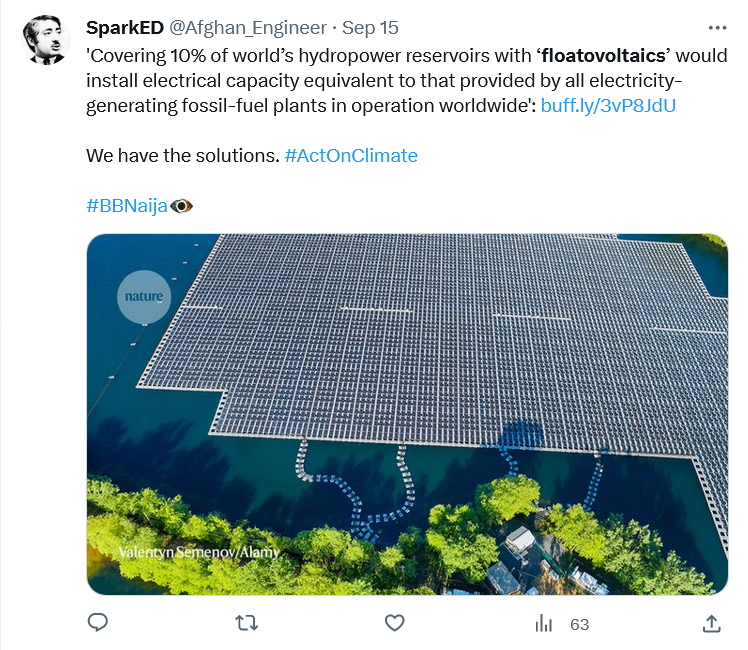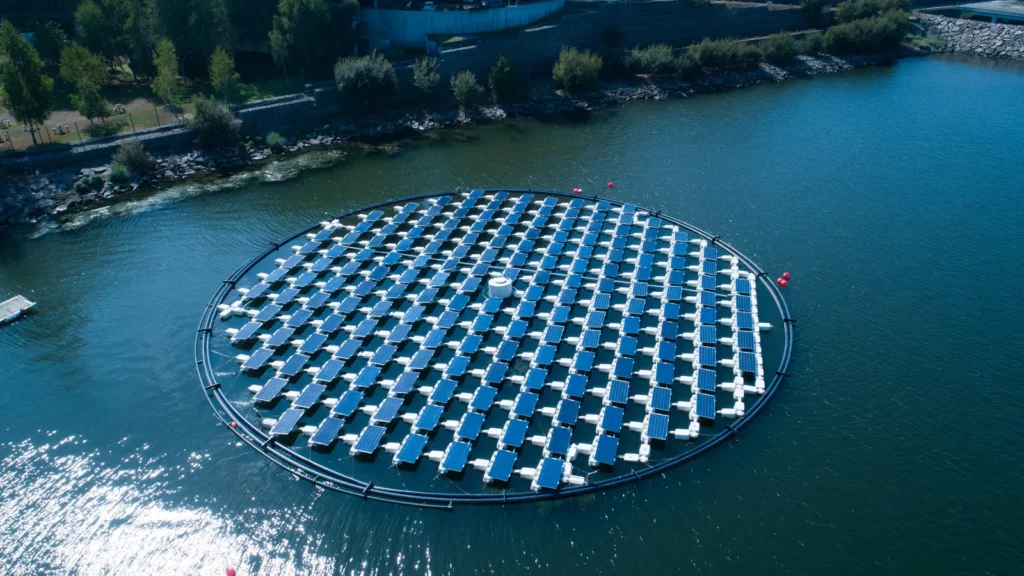
- Floating solar panels might be the answer to effective use of the renewable power source.
- Huge solar farms have sprung up in Asia, and the US would benefit from floating solar panels too.
- While the jury’s out on their ultimate effect on habitats, floating solar panels are gaining popularity.
Solar energy is the cheapest renewable energy resource – its price even dropped by 85 percent during the 2010s. Like most solutions to our energy needs, though, it has its problems: it’s less energy-dense than fossil fuels, and is far more land-intensive. A key problem with solar power is the massive amount of space needed to house solar farms, especially in countries facing land scarcity or where land is needed for other uses. Land-based solar farms require at least 40 to 50 times more space than coal plants and 90 to 100 times more space than gas, and can have a detrimental effect on biodiversity. Using floating solar panels could free up land for agricultural use and habitat conservation.
Also known as floating photovoltaic systems or ‘floatovoltaics,’ floating solar panels function the same way as land-based panels, organized in clusters which are divided by walkways for maintenance crews. In this case, they rest on a floating platform and are held in place by cables connected to the bottom of a suitable body of water, which can include lakes, ponds, reservoirs, dams, and offshore waters. There is some slack in these cables to account for changes in the water level during storms and droughts.

Floating solar panels for the green tech win?
Solar panels generate electricity using rays of light from the sun, not heat. In fact, they become less efficient if they get too hot, as heat decreases the voltage and the amount of electricity generated. Solar panels are most efficient at temperatures between 59F and 95F (15C and 35C), but they can reach temperatures as high as 149F (65C). Being in close proximity to water can keep the panels cool and help them to operate more efficiently, increasing their electricity production by up to 15%.
Although two-thirds of our planet’s surface is covered by water, floatovoltaics currently make up only around 2 percent of all domestic solar installations. A study published in Nature Sustainability in March, 2023 estimated that over 9,000 terawatt hours of energy could be produced globally each year if 114,555 reservoirs worldwide had 30% of their surface covered with floatovoltaics. That’s around 2.4 times the amount of electricity consumed in the US in 2021.
The relationship between floatovoltaics and the reservoirs on which they rest is symbiotic, because they can help save water by shading it from the sun and reducing evaporation. When installed on hydroelectric dam reservoirs, they therefore multiply the existing hydropower by preserving more water for electricity.
The study’s findings suggest that deploying the stated number of panels worldwide would save enough water to fill 40 million Olympic swimming pools, or supply 300 million people per year – an attractive prospect in the face of climate change-induced water scarcity.
Asia’s floating solar panels
This floating solar technology was pioneered in India’s Gujarat state, where the Sardar Sarovar dam and canal project was inaugurated in 2012 by prime minister Narendra Modi, then the chief minister of Gujarat. The project was an ambitious one, and now provides water to hundreds of thousands of villages in the arid regions of the western state. Although engineering firm Sun Edison promised to build 19,000km of solar canals, however, only a handful of small projects have been completed, and the firm has since filed for bankruptcy. Both capital costs and maintenance have been cited as issues.
Initial installation costs for floatovoltaics are about 10 to 15 percent higher than their land-based cousins, and while the equipment is designed to last up to 30 years, corrosion can affect their durability and require more maintenance, especially in water with higher salt content. Solar energy is also intermittently reliable in that it doesn’t work when the sun isn’t out.

These floating solar panels follow the sun. Source: BBC.com
In India, the panels in the Gujarat pilot project sit directly over the canal, which limits access for maintenance and emergency crews. This, alongside the ample arid land available for ground-based solar energy, has prevented widescale adoption of the technology in India.
Recent years have seen the construction of massive solar farms, particularly throughout Asia: Singapore’s Tengeh Reservoir, for example, spans 45 hectares. Experts, however, have highlighted the need for further research into the potential impacts of floating solar farms, and how they might be mitigated. The shade might prevent the growth of aquatic plants, for instance, or cause issues for waterfowl and migrating birds. Concerns have also been raised that floating panels might reduce oxygen levels in water, thereby negatively impacting fish, and could potentially negatively impact water quality as well.
In Thailand, the 720,000 square meter Sirindhorn dam project is comprised of 144,000 solar panels and forms part of a plan to achieve net-zero emissions by 2065 – but locals have criticized the project for forcing them out of areas traditionally used for fishing, thereby affecting their livelihoods.
Despite the potential issues, this technology is gaining popularity worldwide, and is currently booming in the USA. The US has around 26,000 reservoirs of varying sizes and would therefore especially benefit from wide-scale floating solar energy.
Since many reservoirs are already equipped with hydroelectric dams, they already have the infrastructure to carry solar power to cities, and the two power sources easily complement each other – solar during the day, hydroelectric at night.
“Energy is such a big problem, we’re not going to have one silver bullet,” said J. Elliott Campbell, co-author of the Nature Sustainability paper, quoted in a Wired article. “We need floating photovoltaics and about a hundred other things to satisfy our energy needs.”









